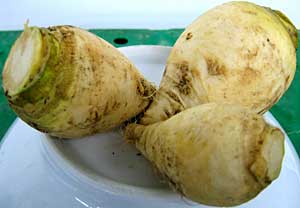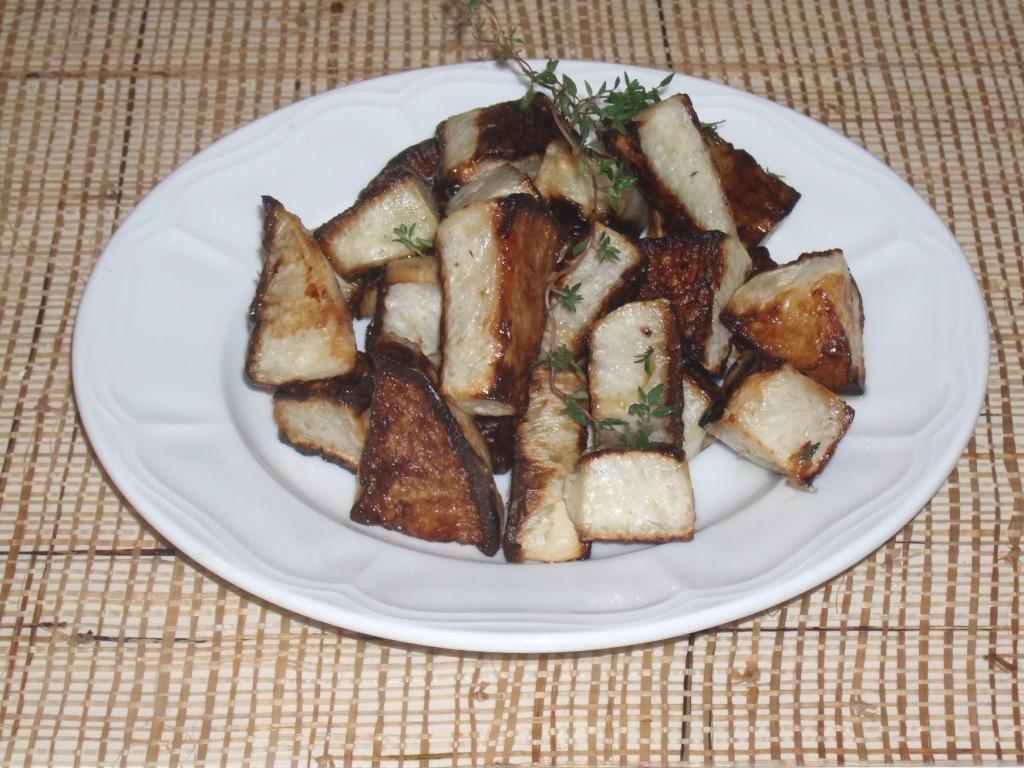 I was gifted last night with two specimens that looked a lot like large shrunken heads. One weighed a little more than two pounds, the other closer to three -- similar to the weight of a human brain. But these were no ordinary gifts. They had a unique provenance, discovered in a sleepy Vermont town in the early 1900's. My friend, pleased as punch to plunge these offerings into my arms, informed me with a Cheshire grin, that I was the proud recipient of two bona fide Gilfeather Turnips celebrated by yearly festivals, commemorated in poetry, and one of only two vegetables registered on the list of heirloom varieties in Vermont. The tuber in question is large and egg-shaped with crannies and crevices and a rough outer covering. (It is easily peeled with a vegetable peeler.) It was "discovered" by the bachelor John Gilfeather in Wadsboro, Vermont whose population could fit into the dining room of Tao on a quiet night (pop. under 900). The fairweathered Gilfeather (say that three times fast!) was cunning: he cut off the tops and the roots from his turnips so that his variety could not be reproduced. Nonetheless it has survived his demise and has achieved culinary status as a member of Slow Food's Ark of Taste. But when it comes to the art of taste, the unusual, sweet root has demonstrated great versatility and finesse.
At 6:35 a.m. (instead of sticking my finger in yesterday's carrot cake), I cut the smaller 2 pound turnip into large chunks and laid them out on a rimmed baking sheet. I coated them lightly with olive oil and liberally sprinkled them with kosher salt. In a preheated 400 degree oven, I roasted them for 20 minutes, turned them over and continued cooking them for another 20 minutes. They were dark golden brown and delicious. But the roasting concentrated the natural sugars and were a bit too sweet. A little more salt? Didn't quite do it. But then I sprinkled on just a few drops of rice vinegar and oh boy, was that fabulous! It made the turnip taste a bit like Jerusalem artichokes. Also delicious was the addition of fresh thyme leaves from my window box. Fresh rosemary was also a felicitous match.
I was gifted last night with two specimens that looked a lot like large shrunken heads. One weighed a little more than two pounds, the other closer to three -- similar to the weight of a human brain. But these were no ordinary gifts. They had a unique provenance, discovered in a sleepy Vermont town in the early 1900's. My friend, pleased as punch to plunge these offerings into my arms, informed me with a Cheshire grin, that I was the proud recipient of two bona fide Gilfeather Turnips celebrated by yearly festivals, commemorated in poetry, and one of only two vegetables registered on the list of heirloom varieties in Vermont. The tuber in question is large and egg-shaped with crannies and crevices and a rough outer covering. (It is easily peeled with a vegetable peeler.) It was "discovered" by the bachelor John Gilfeather in Wadsboro, Vermont whose population could fit into the dining room of Tao on a quiet night (pop. under 900). The fairweathered Gilfeather (say that three times fast!) was cunning: he cut off the tops and the roots from his turnips so that his variety could not be reproduced. Nonetheless it has survived his demise and has achieved culinary status as a member of Slow Food's Ark of Taste. But when it comes to the art of taste, the unusual, sweet root has demonstrated great versatility and finesse.
At 6:35 a.m. (instead of sticking my finger in yesterday's carrot cake), I cut the smaller 2 pound turnip into large chunks and laid them out on a rimmed baking sheet. I coated them lightly with olive oil and liberally sprinkled them with kosher salt. In a preheated 400 degree oven, I roasted them for 20 minutes, turned them over and continued cooking them for another 20 minutes. They were dark golden brown and delicious. But the roasting concentrated the natural sugars and were a bit too sweet. A little more salt? Didn't quite do it. But then I sprinkled on just a few drops of rice vinegar and oh boy, was that fabulous! It made the turnip taste a bit like Jerusalem artichokes. Also delicious was the addition of fresh thyme leaves from my window box. Fresh rosemary was also a felicitous match.
 In sum, the real allure of the Gilfeather Turnip is its sweetness and interesting texture. The early Vermont frosts increase the root's dulcet tones. This turnip attracts attention because it does not behave like a turnip, nor look like a turnip. It looks like a big knob of celery root (celeriac), whose mouthfeel is more similar to a rutabaga, but with notes of horseradish and sugar. It is used in soup making, in souffles and casseroles, in turnip bread, and vegetable "cakes." It is also mashed with potatoes. The coupling of potatoes and turnips (regular white turnips) is a recipe known as alabaster. It is the ultimate three-ingredient dish and you might consider it for Thanksgiving. If you are lucky enough to snag a Gilfeather Turnip however, simply roast them as above. They are delicious hot, at room temperature, and quite interesting in the morning.
In sum, the real allure of the Gilfeather Turnip is its sweetness and interesting texture. The early Vermont frosts increase the root's dulcet tones. This turnip attracts attention because it does not behave like a turnip, nor look like a turnip. It looks like a big knob of celery root (celeriac), whose mouthfeel is more similar to a rutabaga, but with notes of horseradish and sugar. It is used in soup making, in souffles and casseroles, in turnip bread, and vegetable "cakes." It is also mashed with potatoes. The coupling of potatoes and turnips (regular white turnips) is a recipe known as alabaster. It is the ultimate three-ingredient dish and you might consider it for Thanksgiving. If you are lucky enough to snag a Gilfeather Turnip however, simply roast them as above. They are delicious hot, at room temperature, and quite interesting in the morning.
Alabaster (Turnip and Potato Puree) This is creamy and white as alabaster.
2-1/2 pounds large white turnips 2-1/2 pounds large red-skinned potatoes 8 tablespoons unsalted butter
Scrub turnips and potatoes but do not peel. Place in a large heavy pot with a cover and add salted water to cover. Bring to a rapid boil then lower heat to medium. Cover and cook 40 minutes, or until vegetables are very soft. Drain in a colander. Peel turnips and potatoes under cool running water. In a large bowl, mash both vegetables well with a potato masher. Add butter, a little at a time. Add salt and white pepper to taste, then whip with a wire whisk until smooth and fluffy. Serve immediately or reheat over low heat. Serves 6 or more